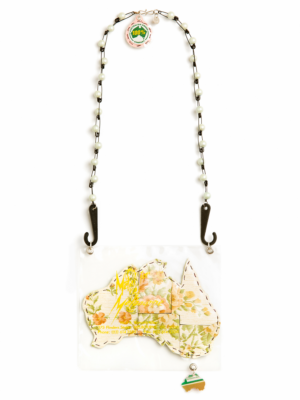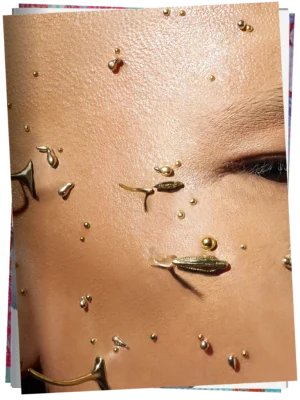In the first part, we’ve embarked on a journey that outlined the routes defining the map documenting the Argentinian jewellery scene, the intersections of landscapes, their materials, as well as the connections between the jewellers, their workshops, and the local communities. But on these routes, reflective of the routes in Argentina, there are potholes that make it challenging. Yet, in the face of these challenges, jewellers Echelle, Nirino, and Ramos demonstrate remarkable resilience. In any material-based practice, learning to work with materials requires patience, time, and a lot of trial and error, and jewellery is no exception.
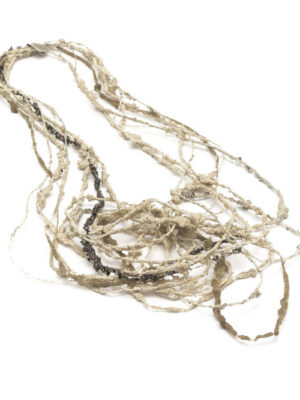
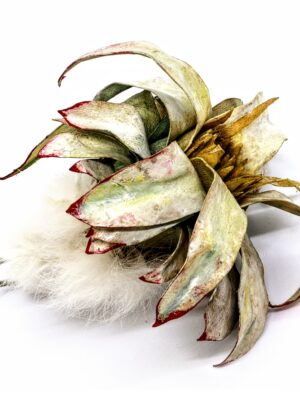

___STEADY_PAYWALL___
After working with and incorporating leather into her jewellery practice, Echelle had to face a new challenge that this material brought with it: the microorganisms that lived on its surface. To solve this problem, Lena used her knowledge of tanning leather. In this process, the leather becomes rot-proof, a practice that has been in place since 2500 BC.
Inspired by the coastal landscape, Ramos began working with sand to represent the fragility of the material in its pure form. However, her pieces were rugged and compact; when she tried to make thin pieces, they broke or fell apart due to carelessness. The pieces are ephemeral, which prompts the question, what does it mean if the pieces don’t last? Eventually, Ramos got closer to what she sought after through playing and mixing sand and vinyl glue.
Although Gabriela Nirino had knowledge of and had researched Chala, she encountered the material’s pitfalls and hardness. She began to refine the fibres with her nails, and through constant experimentation and curiosity, she learned how to prevent them from breaking. Focused in her workshop and working with her hands, often leaving marks on them, Nirino eventually uncovered the fibre’s softness. Persistence proved to be her most significant tool.
The potholes the three artists/jewellers encountered on this route were overcome by playfulness. Their research involves hands-on experimentation in their workshops, trying new techniques, and being willing to fail. The result is an aesthetic they share, positioned between craftsmanship and artistic research. This aesthetic is configured as an intersection. On one hand, we have artisanal practices where the rustic predominates: the material is seen as it is, and it is clear that it was made by someone’s hands. On the other hand, we have artistic practices dedicated to research: the materials are transformed, they pretend to be something they are not, and the concept prevails. The aesthetic that characterises contemporary Argentine jewellery is a mixture of both. There is serious research into the materials, and the pieces have strong conceptual bases. However, the rustic occupies, visually, a fundamental place. Before the concept, we first observe its strangeness linked to the material. The first question that arises is, what is this? A question that leads to an action: wanting to grab the piece, almost as if it were in a craftsman’s shop.
These jewellers, in their distinctive way, primarily rely on their hands. This approach is not just a result of economic constraints, but a proud part of their identity: the belief that the only thing that truly matters is commitment.
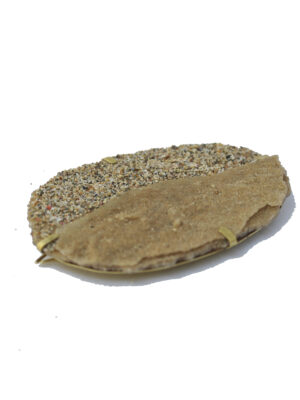

The works of contemporary Argentine jewellery are presented with the seriousness of artistic research and the closeness of craftsmanship. The three jewellers approach craftsmanship as they know the materials with which they work exhaustively. One thing characterises all three: the almost non-existent use of tools. Due to the local economy’s ups and downs, purchasing specialised jewellery tools might be challenging. Individual jewellers’ workshops are meticulously built over time, with apprenticeship workshops playing a vital role in project development. The concept of ‘making with what you have at hand’ applies not just to materials, but also to tools. These jewellers, in their distinctive way, primarily rely on their hands. This approach is not just a result of economic constraints, but a proud part of their identity: the belief that the only thing that truly matters is commitment. But at the same time, far from being rudimentary works, they are pieces overflowing with vitality, a testament to their boundless creativity.
But how far do these routes go? What is the destination of those paths that intersect? Lena’s pieces concretise a particular vision of her environment. With leather, a complex flora mirrors the natural flora surrounding it. In her own words, what she does is botanic prospecting on foot and then translating what she sees. The exciting thing about the choice of leather as the primary material is that it is complementary to what it represents. Thus, in the same jewel, flora and fauna coexist. The fluff from the rabbit’s skin is transformed into cotton-like fibres that surround the seeds. The mane of a mule becomes the spines of a cactus, and the leather of a goat becomes basil. With her pieces, Lena transmits the peace and delicacy of the Rioja landscape. Lena accompanies her husband, a researcher dedicated to palaeontology, on his tours. There, she takes photos and draws the native plants. To this form of documentation, she adds the subsequent work in jewellery. Echelle’s meticulous pieces work as a way of documenting and, therefore, preserving her environment.
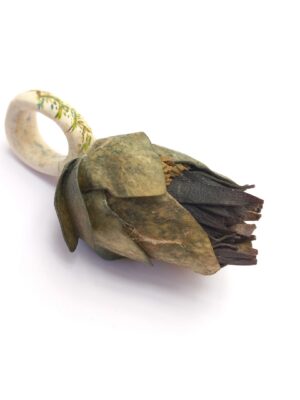

Just as Lena Echelle disrupts the material to simulate one element for another, Gabriela Nirino seeks the opposite with the pieces that make up the Chala collection. Her thoughts resonate with the way pre-Columbian communities conceive material. Plants are beings. They possess vitality, agency, and a history of their own. In pre-Columbian communities, corn plays a central role. Religion and the sacred are linked to the plant, but not in a static and reverential sense. The cycle of the plant is directly related to the cycle of life. In her book Vibrant Matter, Jane Bennett works in part with this collection of ideas; she says that ‘organic and inorganic bodies, natural and cultural objects are all affective,’ referring to the capacity for action and reaction that these objects have. Nirino takes up these lines of thought and produces new relationships with this material, one of the most sacred for Latin American cultures, using it to make woven pieces (another ancestral practice in Andean cultures). Not only does she take up ways of making things, such as textiles, from these cultures, but Gabriela also works similarly with the symbolism of corn, although with a contemporary twist. With it, she creates pieces of contemplation.
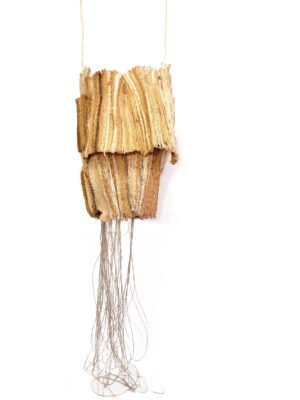

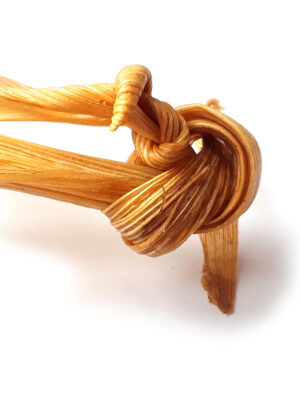
Corn fibres are the main character of these works. Gabriela works the leaf in multiple ways. Twisted, it seems hard; in the shape of a nest, it gives the sensation of stinging, and when you put together small baskets, it gives the sensation that it is caressing you. Like every character, the Chala shows us different faces. She performs in various ways to talk about herself, her ancestral history, and her contemporary use in the food industry.
The place that María Eugenia Ramos seeks to reach with her work is to channel the questions that appear during contemplation. For her, the image that drives her search in the sand is stillness on an empty beach. The sand that delimits the shore between land and sea is plagued with questions. She makes sands from different places coexist in her pieces, seeking to find harmonious combinations. She sees in the sand the possibility of building from fragility, sinking her hands into the sand, into the mud to create something new and to return, at the same time, to the origin.
In their works, the three jewellers tell different stories about Argentina and Latin America and transform the landscape into a tangible, wearable form. They fragment the landscape to transfer it to the body, making contemplation their creative material. The best way to resist life in the south of the planet is to feel through objects. Therefore, their works reflect their artistic journey and creative process and have a profound impact on the representation of Argentina and Latin America. Through the materials and identity elements of these lands, they claim a very personal way of doing things characterised by the appreciation of what surrounds us. From things others discard to producing with their own hands, these jewellers take parts of the landscapes surrounding them to exalt them. And with this powerful gesture, they invite us to rediscover these lands and their vitality.
This article is part of a larger exploratory series called Future Legacy, commissioned by Current Obsession. This theme intertwines sustainability and social change, including a narrative of respect, ceaseless innovation, mentorship, and community. Drawing upon the richness of heritage collections and artefacts, Future Legacy celebrates our collective past while inspiring a socially responsible, sustainable, and inclusive future.
Florencia Kobelt is a graduate in art criticism and above all curious about contemporary jewelry, art, and design. Her interest views those phenomena from a place between the analytical and the sentimental, because there is no criticism without those two factors. She has published reviews of jewellery and other artistic activities (visual arts, theatre) in digital magazines. She has also worked as a curator and is currently working on her own website about contemporary Argentinian jewellery, Ensayo Joyero.
Cover Image:
Lena Echelle
Basil
Goatskin
Photograph by Lena Echelle

